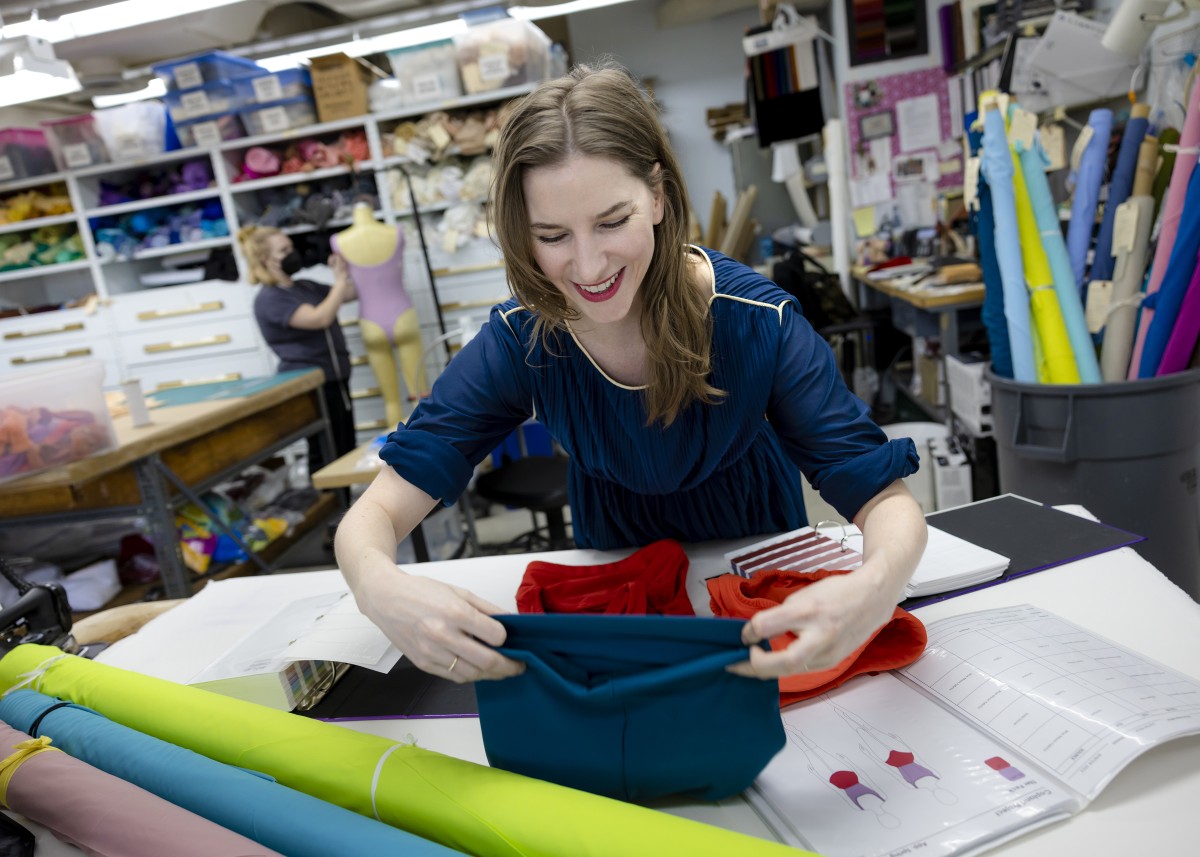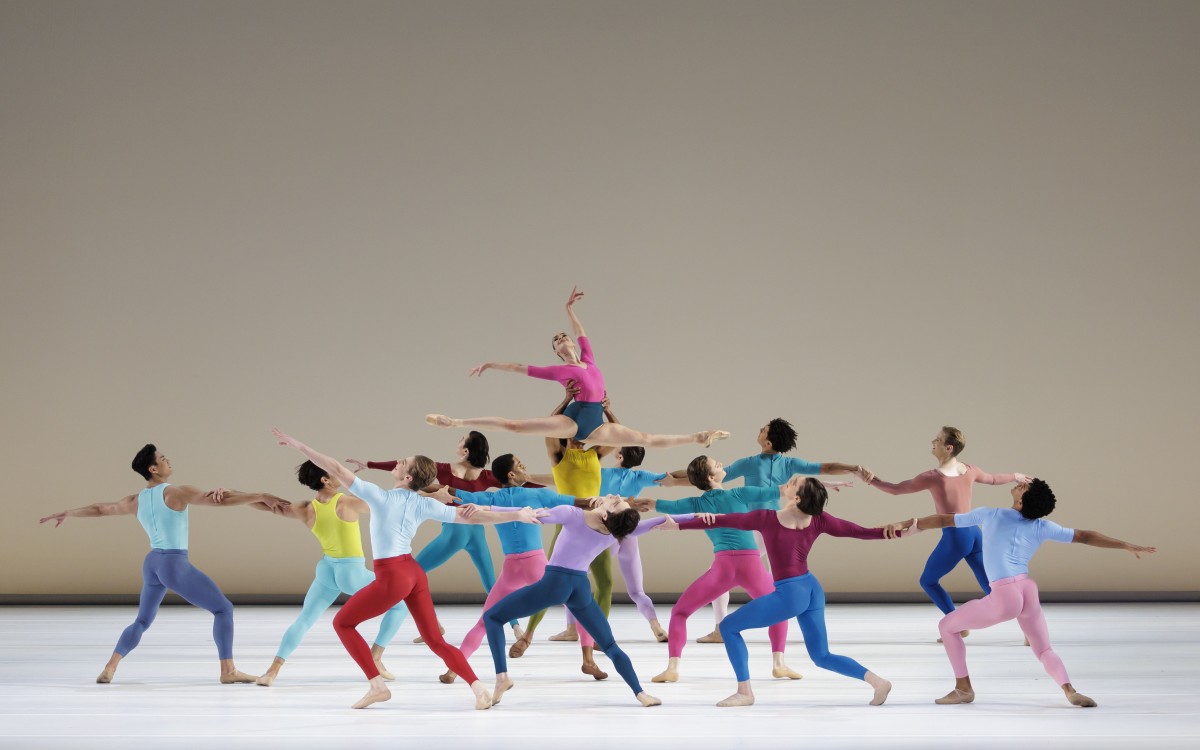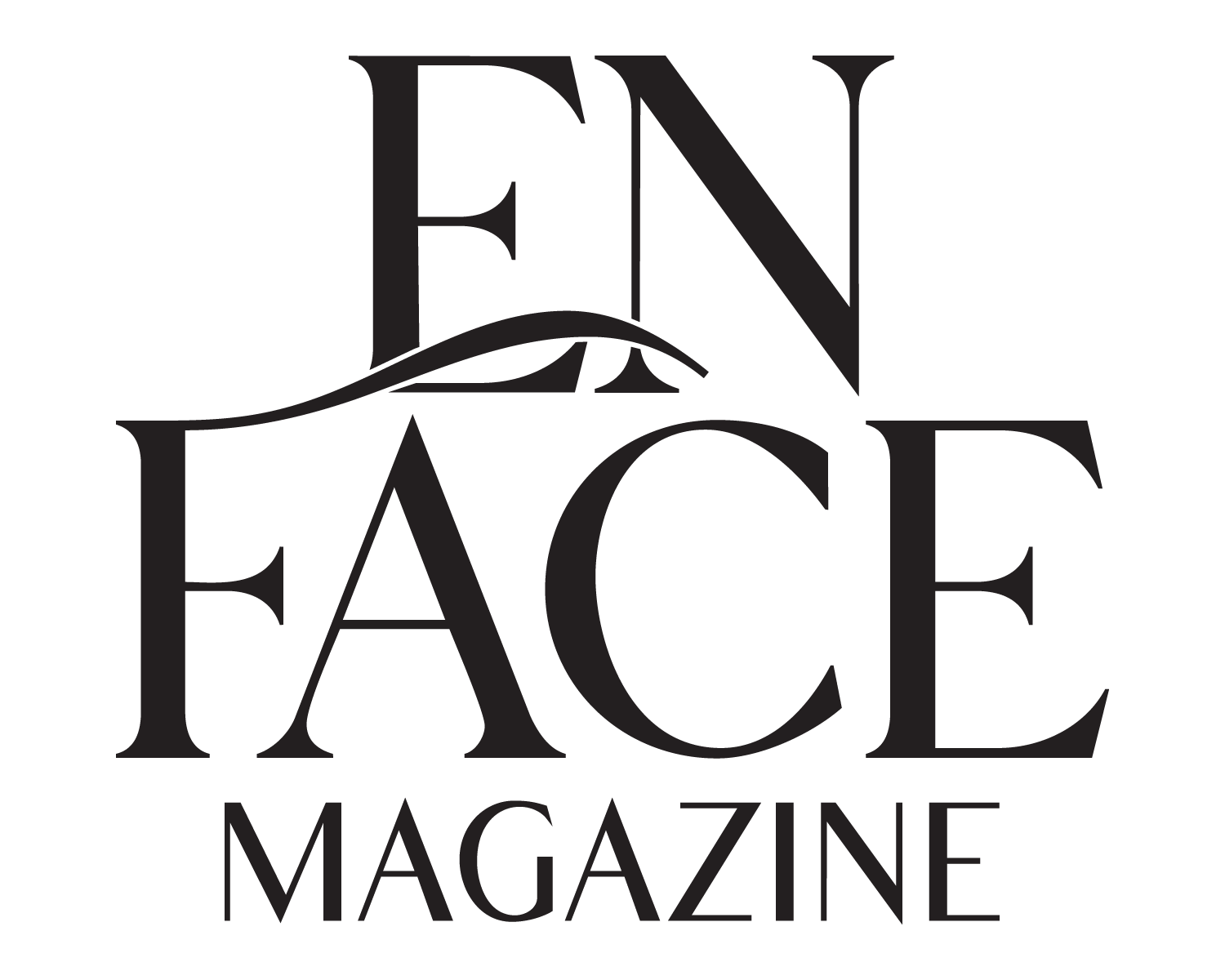
Ellen Warren | Photo by Erin Baiano
Prelude: A Look Inside The Inspirations of Ellen Warren’s Costumes for NYCB’s Copland Dance Episodes
Behind the scenes of every polished work presented under bright shiny lights is a tangled thread of false starts, alternate paths, and unexpected inspirations.
This is the prelude.
It is in the prelude that some of the purest magic of art and creativity can be found. En Face Magazine is proud to celebrate these scattered collisions and the smattering of thoughts that lead to the works we already love or cannot wait to see.
We begin our Prelude series exploring Ellen Warren’s costume design for NYCB’s Resident Choreographer Justin Peck’s Copland Dance Episodes.
Copland Dance Episodes, Peck’s first full-evening work, is a tribute to one of America’s foremost composers Aaron Copland. In collaboration with the painter and sculptor Jeffrey Gibson, Copland Dance Episodes builds on Rodeo: Four Dance Episodes, Peck’s first work set to a Copland composition.
Warren’s bright, bold, color-blocking costume design melds these sources of inspiration to create a delicious feast for the eyes. Learn more about her design process in the interview below and download an En Face exclusive phone background inspired by Ellen’s designs.
It’s so wonderful to be talking with you today Ellen about your costume design for Copland Dance Episodes! But before we get into that, can you tell our readers a little bit about yourself and your background?
EW: My name’s Ellen Warren. I’m from Portland, Oregon. I trained at the Oregon Ballet Theatre School, and danced with the company as a student, and then went to the School of American Ballet at 16, joined New York City Ballet at 18 or 19, and then danced there for about 10 years.
Then I came back to Portland and was a guest artist at Oregon Ballet Theatre, where I then retired. While I was guesting at OBT, I started making my own leotards. I made a batch and sent them to friends at New York City Ballet. And then that’s where this kind of other career I’ve had took off.
Leotard making first started as a necessity for you as a tall dancer. It then developed into a passion that you shared with friends, and has now grown into a full-fledged career and business with Louise Apparel. What has this experience been like for you and in what ways has it been most fulfilling?
EW: It’s been a very hard experience because I had no formal training, I’m home sewn. I’m self-taught, I had no experience in sewing or pattern making or owning a business. I’ve done it on my own; so it’s been very hard. I’ve learned, finally, to get help with things. It’s been a bit by-the-seat-of-my-pants way to grow and to learn all these different skills.
It’s also been fulfilling in that way; challenging and rewarding personally. It feels extra fulfilling maybe in an odd way because I did it by myself, you know what I mean? There’s some pride in there.
After dancing with Justin Peck in New York City Ballet for many years, you’ve started a new collaborative and creative relationship with him through costume design. You just wrapped up your fourth work together, Copland Dance Episodes for New York City Ballet. How did this whole relationship come about and what is your collaborative process like?
EW: Justin Peck actually saw my leotards in the studios of NYCB and he reached out. This is now our fourth collaboration. He just reaches out again and again. Honestly, this last one, it was a dream email.
After collaborating on Reflections for Houston Ballet, I was hoping to get that email one day – [the offer to do ] something at New York City Ballet. It’s like wanting to hear from that person, that everyone’s got, that person where you wonder if they’ll ever reach out again. When I got that email, it was an incredible moment. It was such a massive project to be offered; a full-evening work and a cast of 30 dancers. That was overwhelming because he’s never done a full-length work either.

Ellen Warren | Photo by Erin Baiano
What were some key sources of inspiration for the costuming of Copland Dance Episodes and what spoke to you about the work to guide you to these inspirations?
EW: When Justin first reached out, he sent two Jeffrey Gibson-designed backdrops that the ballet has, as well as the score [composed by Aaron Copland]. I just sat and I listened to it, looking at the drops, and knowing that he wanted simplicity. Just hearing the score alone, that Aaron Copland music, I knew this is big.
I was nervous, a little bit scared, a little bit overwhelmed. I guess that’s how it started. He gave me those visuals and the parameter that he wanted it simple.
I was so pumped. I had a million leotard ideas. I saw a coat, and I’m thought that’d be cool as a leotard. How can I make it a leotard, or a vintage-inspired dress or something? So, I sketched out around 40 different ideas. Justin was like, “these are great, these are awesome, but… we really like what you already do”. I was a little bit deflated at that moment of the process, but then I thought, okay, let’s get to what my roots are.
One of the most immediate and most striking features of the Copland costumes is the phenomenal color palette. It is huge! How did you organize such a large palette and was there choreographic influence in your choice making?
EW: Looking at Jeffrey’s drops, I thought here’s your palette essentially. My husband’s a photographer and photo editor, so we went through and color coded both the drops. There are close to 160 colors. It was my palette to work with. That was another overwhelming moment with so many colors to figure out. I went through Adobe Illustrator, which I learned on YouTube again, and I made all these swatches and started pairing colors together and decided the parameters. Every dancer would have two colors and each color would be used only once.
That was exciting because I love pairing colors together. I love pairing colors where you can’t decide if they clash or look amazing. I like to skirt that line.
And then choreographically it needed to make sense. There’s a quintet, there are female and male quintets, trios, a corps de ballet, and the two couples. We want them to be in conversation, but not the same. It was actually a lot of fun to then figure it out. Like a 60-color Rubik’s Cube!
When you were listening to the score, was there a particular movement that spoke to you and influenced some of the resulting designs?
EW: Certainly the Rodeo music. I knew overall that I wanted it to feel a bit bright – I wanted everyone to feel bright in their own way. The music influenced that because it’s so electric.
There are points where the music felt so grand and heavy at the same time. Your mind goes to dark and deep colors. When I first heard that I actually pictured it being all dark. It kind of feels like being human where you may feel a heavy feeling, but then there’s also a lightness or a growth and a realization within it. This was an opportunity to bring color in like this. Just because the music is heavy and dark doesn’t mean it can’t feel like a light in a way.
I have to mention Brandon Sterling, the lighting designer, is a huge part of this collaboration. His lighting is incredible and he lit this in a really beautiful way. And the incredible fabric dyer at NYCB, Marie Deserto, who was an intrical, immensely talented part of this creation. Just mind-blowing how she could fine tune fabrics to get those 60 singular colors.
Did you start the design process before seeing any of the choreography?
EW: He had already choreographed Rodeo, which is included in Copland, I think in 2015. So I had seen Rodeo and knew that they were the different male groupings. I only had that to go from.
When I actually got to see it with the costumes, it was really exciting. It was a synthesis moment of it feeling like it all came through with his choreography. There was a cool moment too, that first rehearsal with Justin. He had us, all 100 of us, in a circle and go around and say what color we were feeling that day. So that was also really fun. I got to note what colors I could remember that people said. I said bright red because I didn’t know I would be speaking.

New York City Ballet dancers in Justin Peck’s Copland Dance Episodes | Photo by Erin Baiano
On top of running Louise Apparel and designing costumes, you recently became a mother. Has motherhood impacted you as a creator and a business woman?
EW: I kind of feel really separate identities with that. It’s an interesting question. Is it weird if I say no? Having a child, I suddenly felt this new role. My role as a business woman and creator feel like a separate thing that I go and focus on.
When you become a mother, you kind of reevaluate your identity. I think it’s a special part of me that I like to keep [to myself]. If there was a way it’s influenced me as a businesswoman, it would be that I have to take care of myself to be able to be all the things. Whereas before, maybe as a dancer, I would really burn myself out.
Being a mother has taught me that you can’t give everything to everyone. [If you try to do that,] none of your dreams or goals will happen, and your child won’t get what they need. I try to give everyone the same balance.
Costume design inevitably affects the perception of a piece of choreography. Why does what is worn have a profound impact on both the dancers wearing the pieces and the audience members seeing the work?
EW: If you’re wearing a costume you feel good in, that brings you confidence. It totally shines through in your performance. I think the audience can feel that the costume has gelled or is part of their being. You can see it come through in the performance for sure.
Actually, this is like a funny small note, but a few times people have reached out after seeing a work. One was Houston Ballet and a couple of people from Copland, specifically asking for color swatches because they were like, I need these colors in my life.
I love that people can take it home into their own lives. Either their home or their own wardrobe. That’s been something I never expected.
You were talking a little bit about the lighting designer. How did the lighting impact what type of colors you were choosing? How did those things relate in that collaboration?
EW: Specifically for Copland, it was the first work that Justin had done where it was a white floor and a white backdrop. New York City Ballet or Justin had never done so with Brandon Sterling, the lighting designer.
He told us that it would make the colors very strong. There would be no color contamination so the colors you pick are going to be THE colors. I felt some pressure with this. The ballet’s all about the colors. Again, it’s why the design is a simple V-neck scoop with minor variations to add into that individuality.
With those 40 or so other designs that you made, any chance we will see them in future projects and endeavors?
EW: Yeah. They’re all being held onto. Actually, I’m working on a couple designs [for Louise Apparel] that are going to be like a couple of the Copland costumes; one just with sleeves and other variations. All the other ones that are more adventurous, they’re all tucked away for another opportunity.
Weave the bold colors of Ellen Warren’s costume design into your own life by downloading the free, En Face Magazine exclusive, phone wallpaper here.
Join us in the upcoming weeks as we explore the Preludes of other amazing works in the ballet community. Who do you want to hear from next? Let us know in the comments!
![]()

Thomas Baker is a retired dancer living in Williamsburg, Brooklyn. He loves all things performance, art, and design.
Alanna Love is a writer based out of Boise, Idaho. She revels in tracing the thread of beauty woven throughout daily life, especially when it is found in ballet, literature, or historical wardrobing.

Follow Us
Subscribe For Updates & Giveaways!
Stay up to date with exciting original content, upcoming performances, and giveaways unique to your community and beyond!
